Report on HRM: National Differences, Culture, and Working Policies
VerifiedAdded on 2020/01/28
|7
|2652
|81
Report
AI Summary
This report delves into the critical role of understanding national differences for human resource management (HRM). It examines how varying cultural contexts influence organizational structures, working policies, and employee management. The report highlights the importance of recognizing these differences to achieve organizational goals and improve profitability. It contrasts the working cultures of the United Kingdom and China, providing specific examples of how companies like TESCO and Gionee adapt their HRM strategies to align with local norms and regulations. The report explores concepts like individualism vs. collectivism, power distance, and uncertainty avoidance, illustrating their impact on corporate culture. It emphasizes the significance of open communication, flexible structures, and the adoption of long-term or short-term strategies based on national cultural preferences. The conclusion reinforces the value of cultural sensitivity in HRM for enhancing market share and overall business success.

HUMAN RESOURCE MANAGEMENT
Paraphrase This Document
Need a fresh take? Get an instant paraphrase of this document with our AI Paraphraser
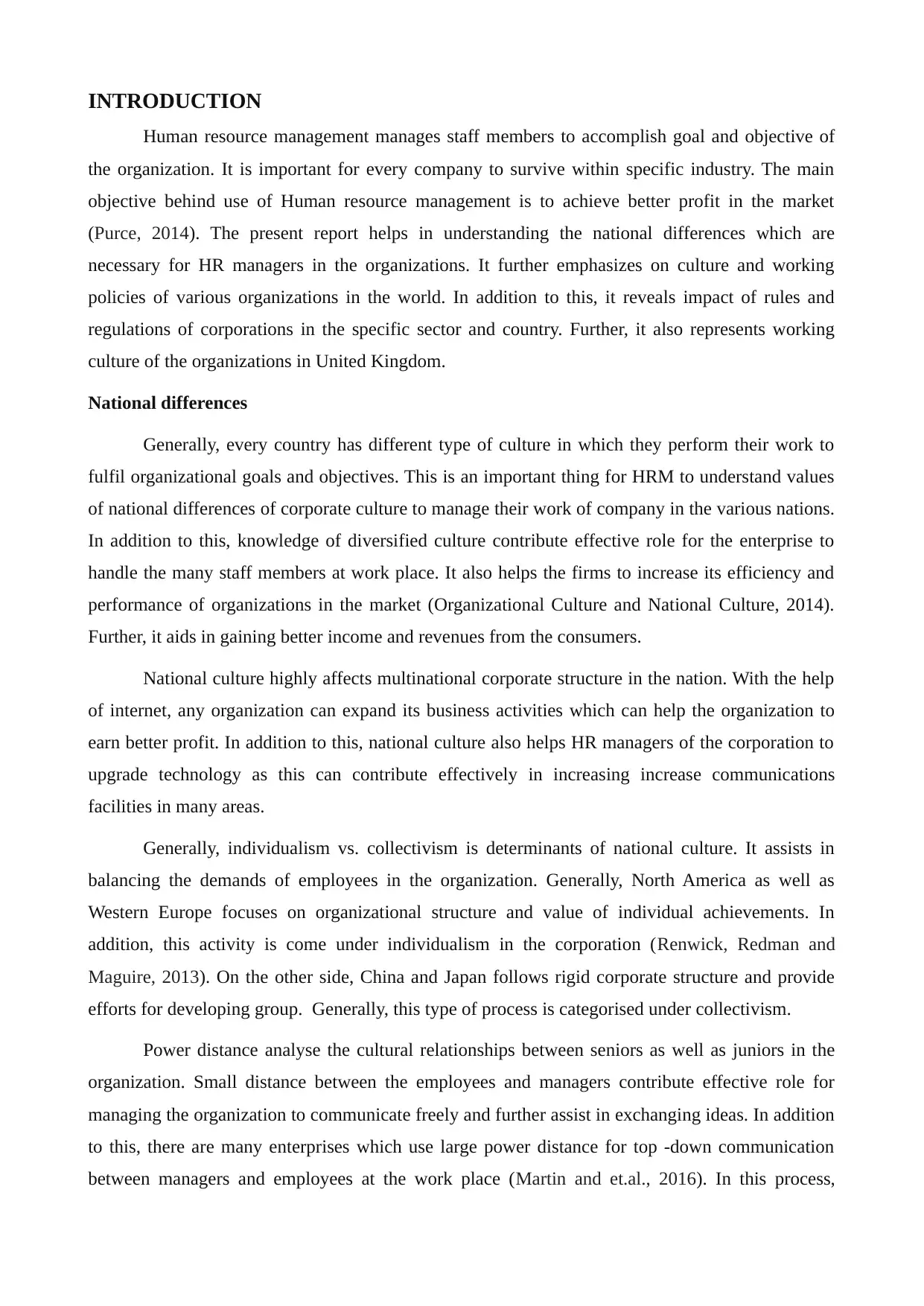
INTRODUCTION
Human resource management manages staff members to accomplish goal and objective of
the organization. It is important for every company to survive within specific industry. The main
objective behind use of Human resource management is to achieve better profit in the market
(Purce, 2014). The present report helps in understanding the national differences which are
necessary for HR managers in the organizations. It further emphasizes on culture and working
policies of various organizations in the world. In addition to this, it reveals impact of rules and
regulations of corporations in the specific sector and country. Further, it also represents working
culture of the organizations in United Kingdom.
National differences
Generally, every country has different type of culture in which they perform their work to
fulfil organizational goals and objectives. This is an important thing for HRM to understand values
of national differences of corporate culture to manage their work of company in the various nations.
In addition to this, knowledge of diversified culture contribute effective role for the enterprise to
handle the many staff members at work place. It also helps the firms to increase its efficiency and
performance of organizations in the market (Organizational Culture and National Culture, 2014).
Further, it aids in gaining better income and revenues from the consumers.
National culture highly affects multinational corporate structure in the nation. With the help
of internet, any organization can expand its business activities which can help the organization to
earn better profit. In addition to this, national culture also helps HR managers of the corporation to
upgrade technology as this can contribute effectively in increasing increase communications
facilities in many areas.
Generally, individualism vs. collectivism is determinants of national culture. It assists in
balancing the demands of employees in the organization. Generally, North America as well as
Western Europe focuses on organizational structure and value of individual achievements. In
addition, this activity is come under individualism in the corporation (Renwick, Redman and
Maguire, 2013). On the other side, China and Japan follows rigid corporate structure and provide
efforts for developing group. Generally, this type of process is categorised under collectivism.
Power distance analyse the cultural relationships between seniors as well as juniors in the
organization. Small distance between the employees and managers contribute effective role for
managing the organization to communicate freely and further assist in exchanging ideas. In addition
to this, there are many enterprises which use large power distance for top -down communication
between managers and employees at the work place (Martin and et.al., 2016). In this process,
Human resource management manages staff members to accomplish goal and objective of
the organization. It is important for every company to survive within specific industry. The main
objective behind use of Human resource management is to achieve better profit in the market
(Purce, 2014). The present report helps in understanding the national differences which are
necessary for HR managers in the organizations. It further emphasizes on culture and working
policies of various organizations in the world. In addition to this, it reveals impact of rules and
regulations of corporations in the specific sector and country. Further, it also represents working
culture of the organizations in United Kingdom.
National differences
Generally, every country has different type of culture in which they perform their work to
fulfil organizational goals and objectives. This is an important thing for HRM to understand values
of national differences of corporate culture to manage their work of company in the various nations.
In addition to this, knowledge of diversified culture contribute effective role for the enterprise to
handle the many staff members at work place. It also helps the firms to increase its efficiency and
performance of organizations in the market (Organizational Culture and National Culture, 2014).
Further, it aids in gaining better income and revenues from the consumers.
National culture highly affects multinational corporate structure in the nation. With the help
of internet, any organization can expand its business activities which can help the organization to
earn better profit. In addition to this, national culture also helps HR managers of the corporation to
upgrade technology as this can contribute effectively in increasing increase communications
facilities in many areas.
Generally, individualism vs. collectivism is determinants of national culture. It assists in
balancing the demands of employees in the organization. Generally, North America as well as
Western Europe focuses on organizational structure and value of individual achievements. In
addition, this activity is come under individualism in the corporation (Renwick, Redman and
Maguire, 2013). On the other side, China and Japan follows rigid corporate structure and provide
efforts for developing group. Generally, this type of process is categorised under collectivism.
Power distance analyse the cultural relationships between seniors as well as juniors in the
organization. Small distance between the employees and managers contribute effective role for
managing the organization to communicate freely and further assist in exchanging ideas. In addition
to this, there are many enterprises which use large power distance for top -down communication
between managers and employees at the work place (Martin and et.al., 2016). In this process,
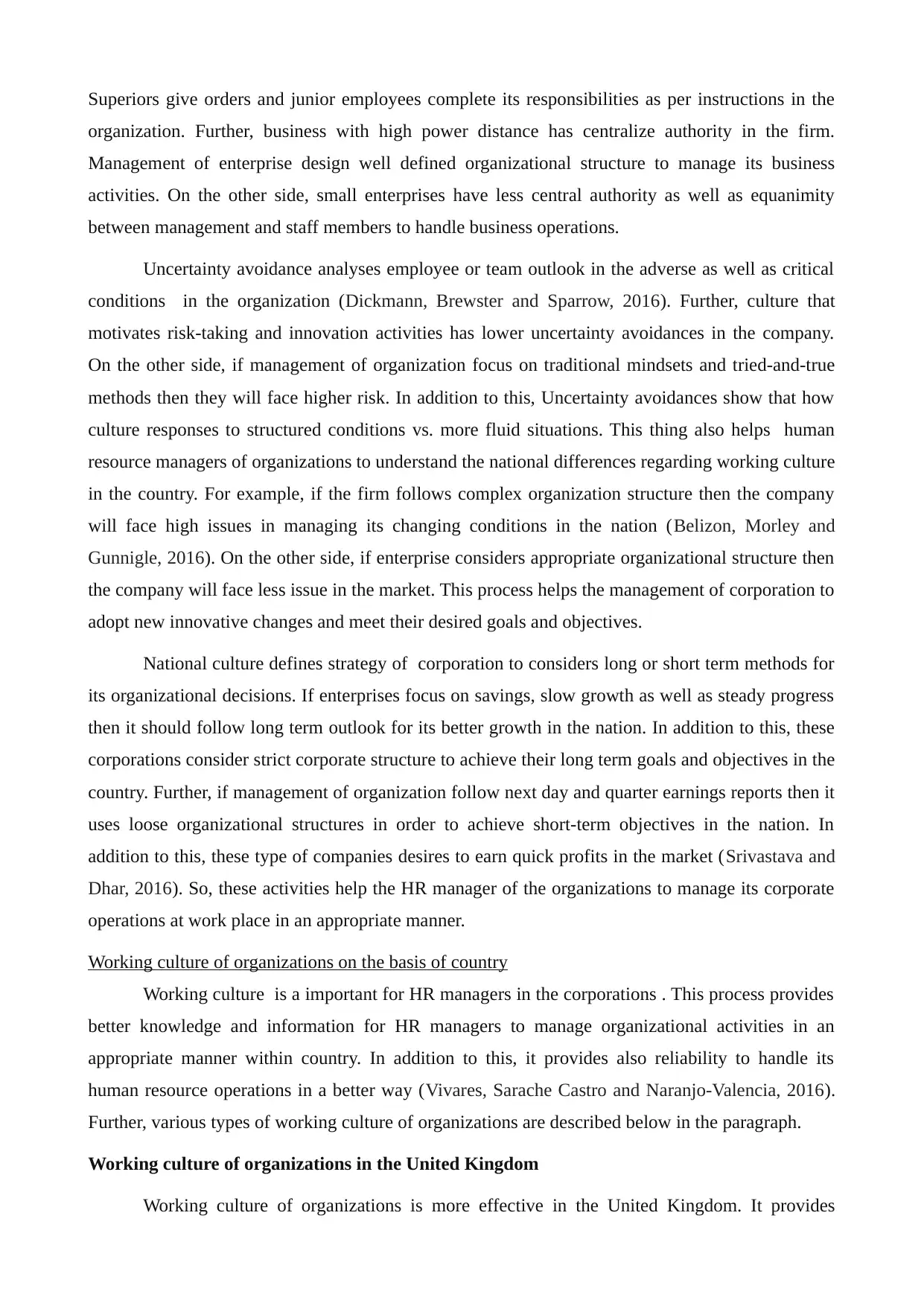
Superiors give orders and junior employees complete its responsibilities as per instructions in the
organization. Further, business with high power distance has centralize authority in the firm.
Management of enterprise design well defined organizational structure to manage its business
activities. On the other side, small enterprises have less central authority as well as equanimity
between management and staff members to handle business operations.
Uncertainty avoidance analyses employee or team outlook in the adverse as well as critical
conditions in the organization (Dickmann, Brewster and Sparrow, 2016). Further, culture that
motivates risk-taking and innovation activities has lower uncertainty avoidances in the company.
On the other side, if management of organization focus on traditional mindsets and tried-and-true
methods then they will face higher risk. In addition to this, Uncertainty avoidances show that how
culture responses to structured conditions vs. more fluid situations. This thing also helps human
resource managers of organizations to understand the national differences regarding working culture
in the country. For example, if the firm follows complex organization structure then the company
will face high issues in managing its changing conditions in the nation (Belizon, Morley and
Gunnigle, 2016). On the other side, if enterprise considers appropriate organizational structure then
the company will face less issue in the market. This process helps the management of corporation to
adopt new innovative changes and meet their desired goals and objectives.
National culture defines strategy of corporation to considers long or short term methods for
its organizational decisions. If enterprises focus on savings, slow growth as well as steady progress
then it should follow long term outlook for its better growth in the nation. In addition to this, these
corporations consider strict corporate structure to achieve their long term goals and objectives in the
country. Further, if management of organization follow next day and quarter earnings reports then it
uses loose organizational structures in order to achieve short-term objectives in the nation. In
addition to this, these type of companies desires to earn quick profits in the market (Srivastava and
Dhar, 2016). So, these activities help the HR manager of the organizations to manage its corporate
operations at work place in an appropriate manner.
Working culture of organizations on the basis of country
Working culture is a important for HR managers in the corporations . This process provides
better knowledge and information for HR managers to manage organizational activities in an
appropriate manner within country. In addition to this, it provides also reliability to handle its
human resource operations in a better way (Vivares, Sarache Castro and Naranjo-Valencia, 2016).
Further, various types of working culture of organizations are described below in the paragraph.
Working culture of organizations in the United Kingdom
Working culture of organizations is more effective in the United Kingdom. It provides
organization. Further, business with high power distance has centralize authority in the firm.
Management of enterprise design well defined organizational structure to manage its business
activities. On the other side, small enterprises have less central authority as well as equanimity
between management and staff members to handle business operations.
Uncertainty avoidance analyses employee or team outlook in the adverse as well as critical
conditions in the organization (Dickmann, Brewster and Sparrow, 2016). Further, culture that
motivates risk-taking and innovation activities has lower uncertainty avoidances in the company.
On the other side, if management of organization focus on traditional mindsets and tried-and-true
methods then they will face higher risk. In addition to this, Uncertainty avoidances show that how
culture responses to structured conditions vs. more fluid situations. This thing also helps human
resource managers of organizations to understand the national differences regarding working culture
in the country. For example, if the firm follows complex organization structure then the company
will face high issues in managing its changing conditions in the nation (Belizon, Morley and
Gunnigle, 2016). On the other side, if enterprise considers appropriate organizational structure then
the company will face less issue in the market. This process helps the management of corporation to
adopt new innovative changes and meet their desired goals and objectives.
National culture defines strategy of corporation to considers long or short term methods for
its organizational decisions. If enterprises focus on savings, slow growth as well as steady progress
then it should follow long term outlook for its better growth in the nation. In addition to this, these
corporations consider strict corporate structure to achieve their long term goals and objectives in the
country. Further, if management of organization follow next day and quarter earnings reports then it
uses loose organizational structures in order to achieve short-term objectives in the nation. In
addition to this, these type of companies desires to earn quick profits in the market (Srivastava and
Dhar, 2016). So, these activities help the HR manager of the organizations to manage its corporate
operations at work place in an appropriate manner.
Working culture of organizations on the basis of country
Working culture is a important for HR managers in the corporations . This process provides
better knowledge and information for HR managers to manage organizational activities in an
appropriate manner within country. In addition to this, it provides also reliability to handle its
human resource operations in a better way (Vivares, Sarache Castro and Naranjo-Valencia, 2016).
Further, various types of working culture of organizations are described below in the paragraph.
Working culture of organizations in the United Kingdom
Working culture of organizations is more effective in the United Kingdom. It provides
⊘ This is a preview!⊘
Do you want full access?
Subscribe today to unlock all pages.

Trusted by 1+ million students worldwide

proper help to human resource managers to control HR activities in the corporation. Maximum UK
based companies use completely open culture as per instructions of government of United
Kingdom. There are many types of working culture such as Adhocracy, baseball team as well as
academy culture which are used many by organizations in the nation. In the adhocracy culture,
company emphasizes to develop and dynamic and innovative ideas with help of diversified staff
members (Para-González, Jiménez-Jiménez. and Martínez-Lorente, 2016). This culture helps the
firm to become leading company in retail sector of United Kingdom (Types of Organizational
Culture, 2013). For example, management of TESCO use adhocracy culture to manage its retail
operations in the industry of Britain. This method aids HR managers of retail organization to
develop effective working system by implementing better rules, regulations as well as policies for
its global staff members in the United Kingdom. Open culture of corporation encourages HR
manager to hire diversified staff members for effective development in the country. It contribute
effective role for TESCO to increase its productivity as well as performance by getting different
knowledge, ideas and concepts from diversified candidates in the retail sector of United Kingdom.
In addition to this, it also helps to motivate employees towards the work in the organization. It helps
TESCO to earn effective profit and revenues from consumers in the nation (Scott, 2016). So,
understanding national differences in working culture are important activity for human resource
manager to stay the organization for long time within retail sector of United Kingdom. On the
other side, there are many private and public enterprises which do not use open culture policies in
the nation. As a result, HR managers face many complexities to manage human resource operations
in the company.
For example, Cadbury is a chocolate manufacturing organization in the world. This
corporation uses open culture to manage its business operations in United Kingdom. In addition to
this, open culture assist HR manager of the organization to manage its activities which provide huge
reliability to increase its performance and efficiency in FMCG sector of UK (Nolan and Garavan,
2016). HR managers of Cadbury recruit and select diversified candidates from various countries.
This approach assist the management of organization to increase its market share by considering
their effective ideas and marketing concepts in the nation. Further, it helps the Cadbury to earn
better from FMCG market of United Kingdom. So, generally this type of working culture helps the
government of Britain to become developed country in the world. In addition to this, understanding
national differences in organizational culture plays major role for HR manger of organizations to
design better policies which aid the firms to increase its growth rate as well as market share in the
United Kingdom (Purce, 2014).
Working culture of organizations in the China
based companies use completely open culture as per instructions of government of United
Kingdom. There are many types of working culture such as Adhocracy, baseball team as well as
academy culture which are used many by organizations in the nation. In the adhocracy culture,
company emphasizes to develop and dynamic and innovative ideas with help of diversified staff
members (Para-González, Jiménez-Jiménez. and Martínez-Lorente, 2016). This culture helps the
firm to become leading company in retail sector of United Kingdom (Types of Organizational
Culture, 2013). For example, management of TESCO use adhocracy culture to manage its retail
operations in the industry of Britain. This method aids HR managers of retail organization to
develop effective working system by implementing better rules, regulations as well as policies for
its global staff members in the United Kingdom. Open culture of corporation encourages HR
manager to hire diversified staff members for effective development in the country. It contribute
effective role for TESCO to increase its productivity as well as performance by getting different
knowledge, ideas and concepts from diversified candidates in the retail sector of United Kingdom.
In addition to this, it also helps to motivate employees towards the work in the organization. It helps
TESCO to earn effective profit and revenues from consumers in the nation (Scott, 2016). So,
understanding national differences in working culture are important activity for human resource
manager to stay the organization for long time within retail sector of United Kingdom. On the
other side, there are many private and public enterprises which do not use open culture policies in
the nation. As a result, HR managers face many complexities to manage human resource operations
in the company.
For example, Cadbury is a chocolate manufacturing organization in the world. This
corporation uses open culture to manage its business operations in United Kingdom. In addition to
this, open culture assist HR manager of the organization to manage its activities which provide huge
reliability to increase its performance and efficiency in FMCG sector of UK (Nolan and Garavan,
2016). HR managers of Cadbury recruit and select diversified candidates from various countries.
This approach assist the management of organization to increase its market share by considering
their effective ideas and marketing concepts in the nation. Further, it helps the Cadbury to earn
better from FMCG market of United Kingdom. So, generally this type of working culture helps the
government of Britain to become developed country in the world. In addition to this, understanding
national differences in organizational culture plays major role for HR manger of organizations to
design better policies which aid the firms to increase its growth rate as well as market share in the
United Kingdom (Purce, 2014).
Working culture of organizations in the China
Paraphrase This Document
Need a fresh take? Get an instant paraphrase of this document with our AI Paraphraser
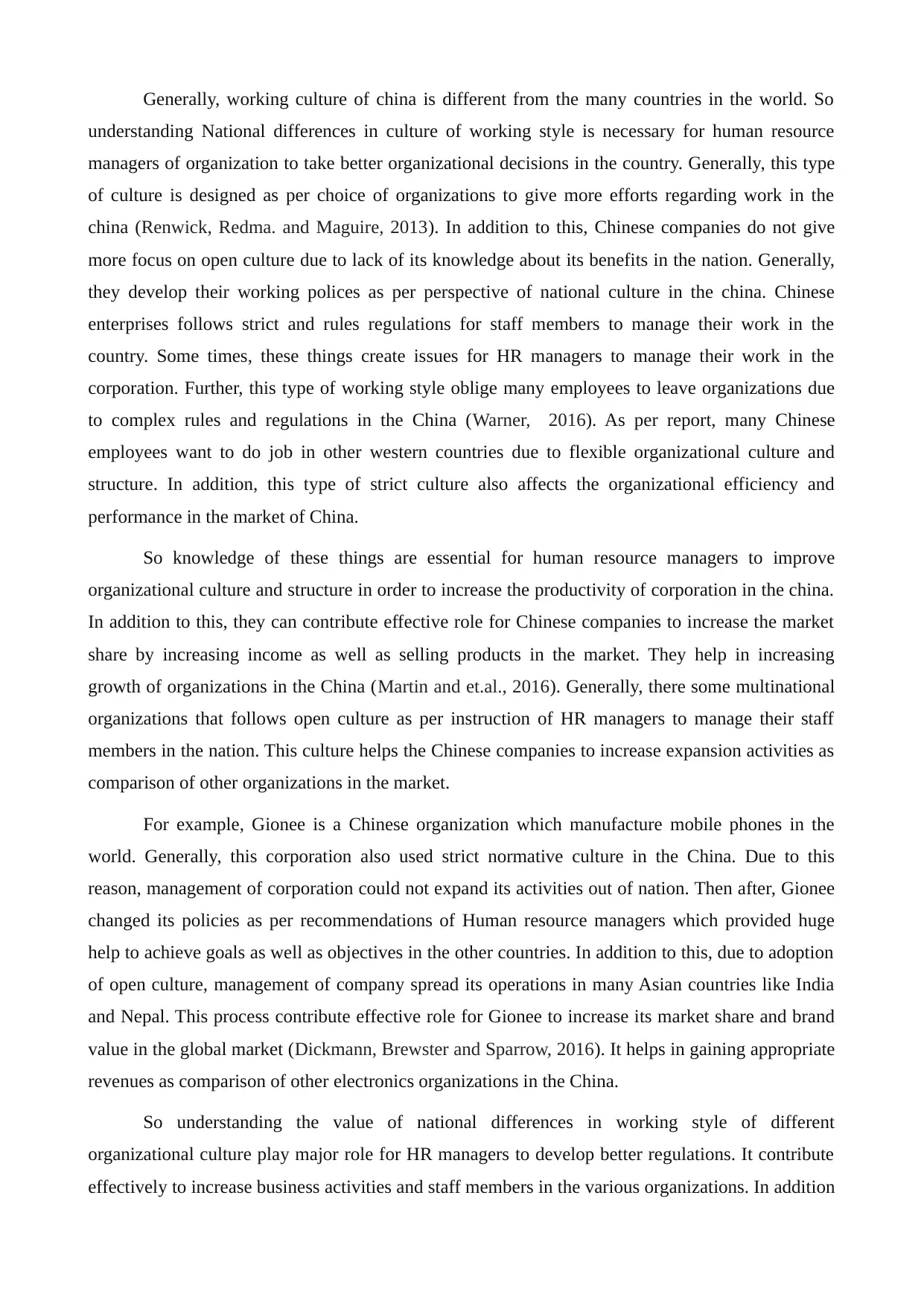
Generally, working culture of china is different from the many countries in the world. So
understanding National differences in culture of working style is necessary for human resource
managers of organization to take better organizational decisions in the country. Generally, this type
of culture is designed as per choice of organizations to give more efforts regarding work in the
china (Renwick, Redma. and Maguire, 2013). In addition to this, Chinese companies do not give
more focus on open culture due to lack of its knowledge about its benefits in the nation. Generally,
they develop their working polices as per perspective of national culture in the china. Chinese
enterprises follows strict and rules regulations for staff members to manage their work in the
country. Some times, these things create issues for HR managers to manage their work in the
corporation. Further, this type of working style oblige many employees to leave organizations due
to complex rules and regulations in the China (Warner, 2016). As per report, many Chinese
employees want to do job in other western countries due to flexible organizational culture and
structure. In addition, this type of strict culture also affects the organizational efficiency and
performance in the market of China.
So knowledge of these things are essential for human resource managers to improve
organizational culture and structure in order to increase the productivity of corporation in the china.
In addition to this, they can contribute effective role for Chinese companies to increase the market
share by increasing income as well as selling products in the market. They help in increasing
growth of organizations in the China (Martin and et.al., 2016). Generally, there some multinational
organizations that follows open culture as per instruction of HR managers to manage their staff
members in the nation. This culture helps the Chinese companies to increase expansion activities as
comparison of other organizations in the market.
For example, Gionee is a Chinese organization which manufacture mobile phones in the
world. Generally, this corporation also used strict normative culture in the China. Due to this
reason, management of corporation could not expand its activities out of nation. Then after, Gionee
changed its policies as per recommendations of Human resource managers which provided huge
help to achieve goals as well as objectives in the other countries. In addition to this, due to adoption
of open culture, management of company spread its operations in many Asian countries like India
and Nepal. This process contribute effective role for Gionee to increase its market share and brand
value in the global market (Dickmann, Brewster and Sparrow, 2016). It helps in gaining appropriate
revenues as comparison of other electronics organizations in the China.
So understanding the value of national differences in working style of different
organizational culture play major role for HR managers to develop better regulations. It contribute
effectively to increase business activities and staff members in the various organizations. In addition
understanding National differences in culture of working style is necessary for human resource
managers of organization to take better organizational decisions in the country. Generally, this type
of culture is designed as per choice of organizations to give more efforts regarding work in the
china (Renwick, Redma. and Maguire, 2013). In addition to this, Chinese companies do not give
more focus on open culture due to lack of its knowledge about its benefits in the nation. Generally,
they develop their working polices as per perspective of national culture in the china. Chinese
enterprises follows strict and rules regulations for staff members to manage their work in the
country. Some times, these things create issues for HR managers to manage their work in the
corporation. Further, this type of working style oblige many employees to leave organizations due
to complex rules and regulations in the China (Warner, 2016). As per report, many Chinese
employees want to do job in other western countries due to flexible organizational culture and
structure. In addition, this type of strict culture also affects the organizational efficiency and
performance in the market of China.
So knowledge of these things are essential for human resource managers to improve
organizational culture and structure in order to increase the productivity of corporation in the china.
In addition to this, they can contribute effective role for Chinese companies to increase the market
share by increasing income as well as selling products in the market. They help in increasing
growth of organizations in the China (Martin and et.al., 2016). Generally, there some multinational
organizations that follows open culture as per instruction of HR managers to manage their staff
members in the nation. This culture helps the Chinese companies to increase expansion activities as
comparison of other organizations in the market.
For example, Gionee is a Chinese organization which manufacture mobile phones in the
world. Generally, this corporation also used strict normative culture in the China. Due to this
reason, management of corporation could not expand its activities out of nation. Then after, Gionee
changed its policies as per recommendations of Human resource managers which provided huge
help to achieve goals as well as objectives in the other countries. In addition to this, due to adoption
of open culture, management of company spread its operations in many Asian countries like India
and Nepal. This process contribute effective role for Gionee to increase its market share and brand
value in the global market (Dickmann, Brewster and Sparrow, 2016). It helps in gaining appropriate
revenues as comparison of other electronics organizations in the China.
So understanding the value of national differences in working style of different
organizational culture play major role for HR managers to develop better regulations. It contribute
effectively to increase business activities and staff members in the various organizations. In addition
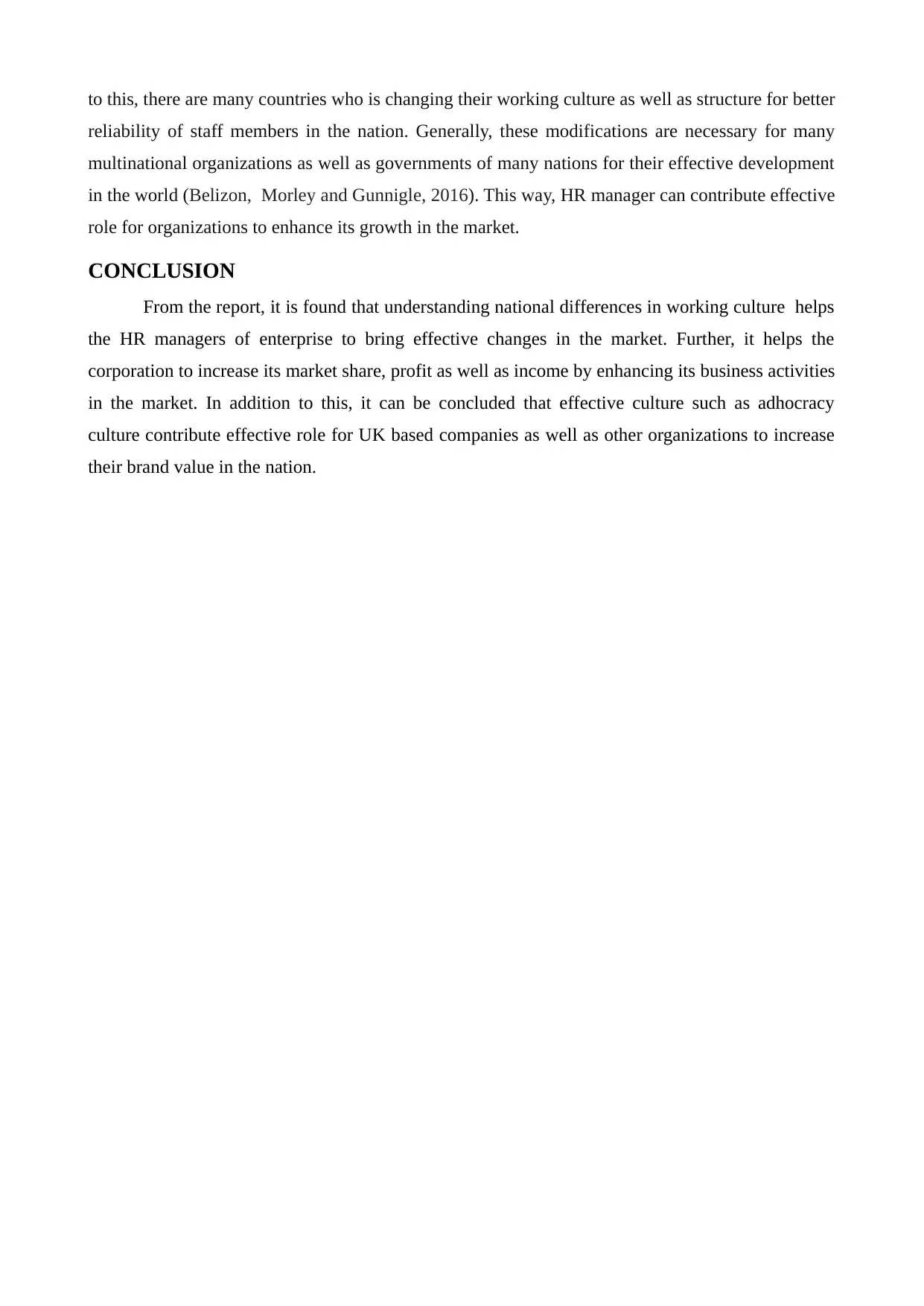
to this, there are many countries who is changing their working culture as well as structure for better
reliability of staff members in the nation. Generally, these modifications are necessary for many
multinational organizations as well as governments of many nations for their effective development
in the world (Belizon, Morley and Gunnigle, 2016). This way, HR manager can contribute effective
role for organizations to enhance its growth in the market.
CONCLUSION
From the report, it is found that understanding national differences in working culture helps
the HR managers of enterprise to bring effective changes in the market. Further, it helps the
corporation to increase its market share, profit as well as income by enhancing its business activities
in the market. In addition to this, it can be concluded that effective culture such as adhocracy
culture contribute effective role for UK based companies as well as other organizations to increase
their brand value in the nation.
reliability of staff members in the nation. Generally, these modifications are necessary for many
multinational organizations as well as governments of many nations for their effective development
in the world (Belizon, Morley and Gunnigle, 2016). This way, HR manager can contribute effective
role for organizations to enhance its growth in the market.
CONCLUSION
From the report, it is found that understanding national differences in working culture helps
the HR managers of enterprise to bring effective changes in the market. Further, it helps the
corporation to increase its market share, profit as well as income by enhancing its business activities
in the market. In addition to this, it can be concluded that effective culture such as adhocracy
culture contribute effective role for UK based companies as well as other organizations to increase
their brand value in the nation.
⊘ This is a preview!⊘
Do you want full access?
Subscribe today to unlock all pages.

Trusted by 1+ million students worldwide
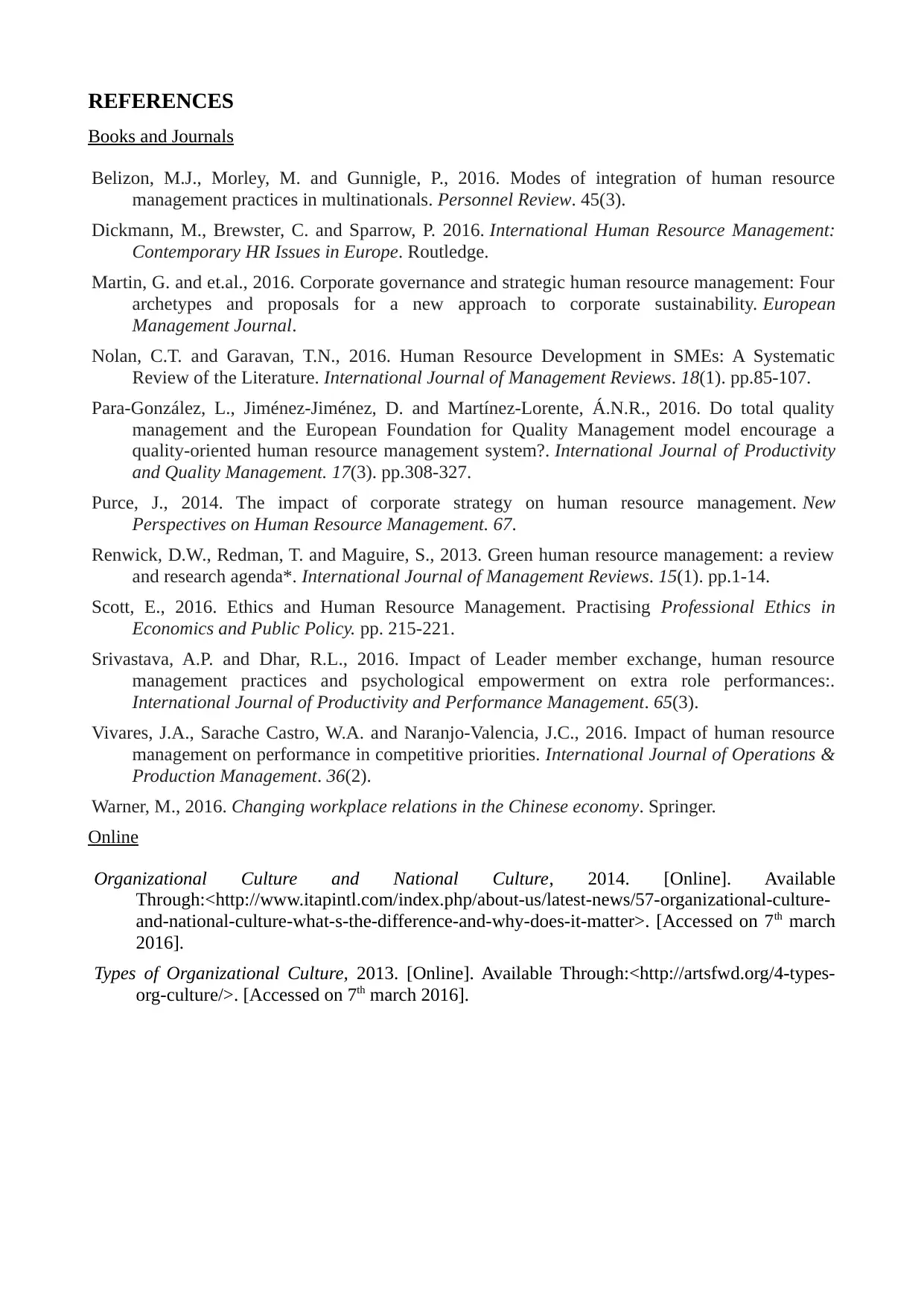
REFERENCES
Books and Journals
Belizon, M.J., Morley, M. and Gunnigle, P., 2016. Modes of integration of human resource
management practices in multinationals. Personnel Review. 45(3).
Dickmann, M., Brewster, C. and Sparrow, P. 2016. International Human Resource Management:
Contemporary HR Issues in Europe. Routledge.
Martin, G. and et.al., 2016. Corporate governance and strategic human resource management: Four
archetypes and proposals for a new approach to corporate sustainability. European
Management Journal.
Nolan, C.T. and Garavan, T.N., 2016. Human Resource Development in SMEs: A Systematic
Review of the Literature. International Journal of Management Reviews. 18(1). pp.85-107.
Para-González, L., Jiménez-Jiménez, D. and Martínez-Lorente, Á.N.R., 2016. Do total quality
management and the European Foundation for Quality Management model encourage a
quality-oriented human resource management system?. International Journal of Productivity
and Quality Management. 17(3). pp.308-327.
Purce, J., 2014. The impact of corporate strategy on human resource management. New
Perspectives on Human Resource Management. 67.
Renwick, D.W., Redman, T. and Maguire, S., 2013. Green human resource management: a review
and research agenda*. International Journal of Management Reviews. 15(1). pp.1-14.
Scott, E., 2016. Ethics and Human Resource Management. Practising Professional Ethics in
Economics and Public Policy. pp. 215-221.
Srivastava, A.P. and Dhar, R.L., 2016. Impact of Leader member exchange, human resource
management practices and psychological empowerment on extra role performances:.
International Journal of Productivity and Performance Management. 65(3).
Vivares, J.A., Sarache Castro, W.A. and Naranjo-Valencia, J.C., 2016. Impact of human resource
management on performance in competitive priorities. International Journal of Operations &
Production Management. 36(2).
Warner, M., 2016. Changing workplace relations in the Chinese economy. Springer.
Online
Organizational Culture and National Culture, 2014. [Online]. Available
Through:<http://www.itapintl.com/index.php/about-us/latest-news/57-organizational-culture-
and-national-culture-what-s-the-difference-and-why-does-it-matter>. [Accessed on 7th march
2016].
Types of Organizational Culture, 2013. [Online]. Available Through:<http://artsfwd.org/4-types-
org-culture/>. [Accessed on 7th march 2016].
Books and Journals
Belizon, M.J., Morley, M. and Gunnigle, P., 2016. Modes of integration of human resource
management practices in multinationals. Personnel Review. 45(3).
Dickmann, M., Brewster, C. and Sparrow, P. 2016. International Human Resource Management:
Contemporary HR Issues in Europe. Routledge.
Martin, G. and et.al., 2016. Corporate governance and strategic human resource management: Four
archetypes and proposals for a new approach to corporate sustainability. European
Management Journal.
Nolan, C.T. and Garavan, T.N., 2016. Human Resource Development in SMEs: A Systematic
Review of the Literature. International Journal of Management Reviews. 18(1). pp.85-107.
Para-González, L., Jiménez-Jiménez, D. and Martínez-Lorente, Á.N.R., 2016. Do total quality
management and the European Foundation for Quality Management model encourage a
quality-oriented human resource management system?. International Journal of Productivity
and Quality Management. 17(3). pp.308-327.
Purce, J., 2014. The impact of corporate strategy on human resource management. New
Perspectives on Human Resource Management. 67.
Renwick, D.W., Redman, T. and Maguire, S., 2013. Green human resource management: a review
and research agenda*. International Journal of Management Reviews. 15(1). pp.1-14.
Scott, E., 2016. Ethics and Human Resource Management. Practising Professional Ethics in
Economics and Public Policy. pp. 215-221.
Srivastava, A.P. and Dhar, R.L., 2016. Impact of Leader member exchange, human resource
management practices and psychological empowerment on extra role performances:.
International Journal of Productivity and Performance Management. 65(3).
Vivares, J.A., Sarache Castro, W.A. and Naranjo-Valencia, J.C., 2016. Impact of human resource
management on performance in competitive priorities. International Journal of Operations &
Production Management. 36(2).
Warner, M., 2016. Changing workplace relations in the Chinese economy. Springer.
Online
Organizational Culture and National Culture, 2014. [Online]. Available
Through:<http://www.itapintl.com/index.php/about-us/latest-news/57-organizational-culture-
and-national-culture-what-s-the-difference-and-why-does-it-matter>. [Accessed on 7th march
2016].
Types of Organizational Culture, 2013. [Online]. Available Through:<http://artsfwd.org/4-types-
org-culture/>. [Accessed on 7th march 2016].
1 out of 7
Related Documents
Your All-in-One AI-Powered Toolkit for Academic Success.
+13062052269
info@desklib.com
Available 24*7 on WhatsApp / Email
![[object Object]](/_next/static/media/star-bottom.7253800d.svg)
Unlock your academic potential
Copyright © 2020–2025 A2Z Services. All Rights Reserved. Developed and managed by ZUCOL.





